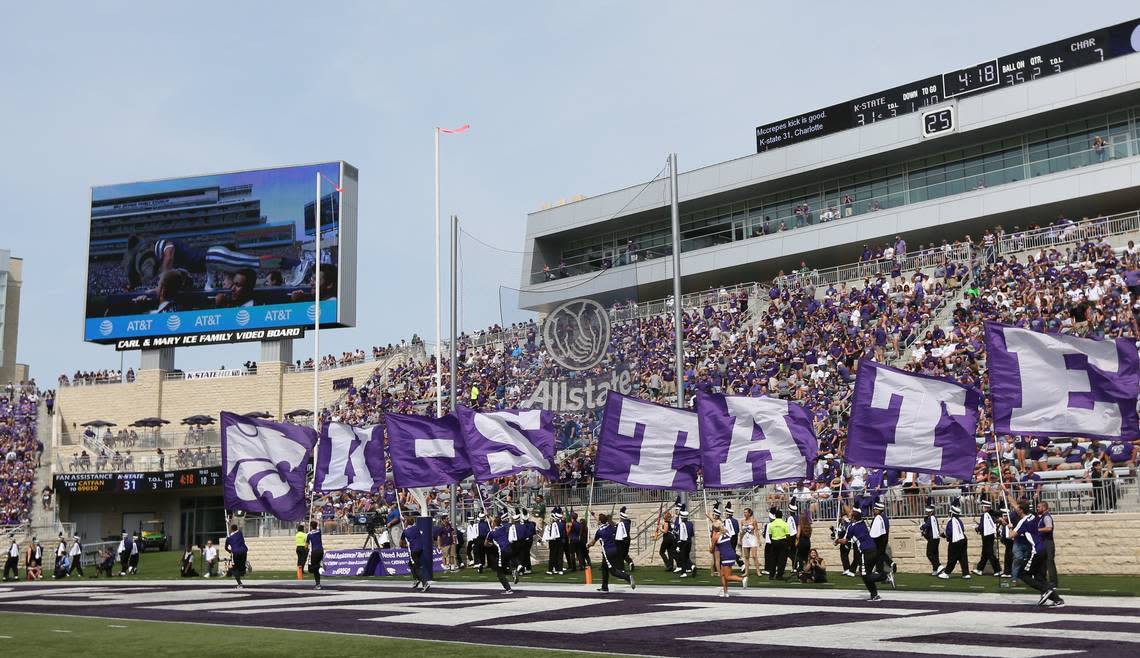Kansas State adjusts travel plans, recruiting approach amid Manhattan airport closure

- Oops!Something went wrong.Please try again later.
- Oops!Something went wrong.Please try again later.
When Kansas State welcomes a recruit to campus for an official visit the experience usually begins at Manhattan Regional Airport.
Coaches greet prospective student-athletes and their families as they arrive in the Little Apple. Then they whisk their guests into town so quickly that they can be at Bill Snyder Family Stadium or Bramlage Coliseum within 10 minutes. Next up is a few days of fun designed to create a lasting impression. The experience ends with a short drive back to the airport where the Wildcats hope they have done enough to gain a new commitment.
At least that is how it usually works.
K-State recently had to adjust its travel system because Manhattan Regional Airport has suspended all flights from May 5 until September 5 in order to construct a new runway. For the next four months, the Wildcats won’t have access to a local airport for travel and recruiting purposes. A major recruiting tool is temporarily out of order.
That means any time a coach from across the athletic department needs to fly for recruiting purposes they must now fly out of Kansas City or Wichita. Whenever most recruits visit campus, they will arrive and depart out of the new KCI. That means every flight will be accompanied by four hours (round trip) of driving on the stretch of I-70 that separates Manhattan and Kansas City.
“That’s a tough one,” K-State baseball coach Pete Hughes said. “Summer is our busiest time of year for recruiting. We are gone all summer long and we’re usually flying out of Manhattan. Flying out of Kansas City is going to add a lot of time to those trips. It’s just a little bump in the road, but it’s definitely going to make things tricky for us.”
Hughes thinks K-State baseball coaches will be able to adjust to the longer commute rather quickly, saying “we are all used to driving.”
But he is not looking forward to hosting his first recruit or transfer from the West Coast on an official visit.
“It is tough to bring in a recruit from California when he’s got to fly for four hours to Kansas City and then he has got to drive two hours to Manhattan,” Hughes said. “At some point in there he’s going to say to himself, ‘Is this the way it’s going to be every time I fly in and out of Manhattan?’ It makes it a tough trip. I like it a lot more when we fly kids in here and it’s a two-minute ride to campus.”
Commuting to and from Kansas City is a problem that K-State coaches had to deal with 15 years ago before MHK began offering daily flights to Chicago and Dallas via American Airlines. Veteran staffers still tell stories about how they became shuttle drivers on busy recruiting weekends. They also had to come up with creative methods of distraction whenever they drove past Lawrence.
Current K-State men’s basketball and football coaches have already adjusted their schedules to accommodate temporary travel plans.
Under normal circumstances, they fly to Chicago or Dallas and then grab a connecting flight to anywhere in the country. Recently, Jerome Tang and members of his staff have mixed in Southwest flights out of Kansas City. Chris Klieman and his staff have also made recruiting trips out of KCI on different airlines.
Tang is trying his best to look at the adjustment as a positive.
“When September rolls around we’re going to have a new airport with a new runway,” Tang said. “Hopefully that will allow them to expand direct options moving forward. I am excited about the future, even though we are dealing with a speed bump right now. We’ll make it through this.”
Tang said he hasn’t hosted a recruit since the airport closure, but he has a plan for making the adjustment as painless as possible.
Back when he worked as an assistant basketball coach at Baylor he said the Bears often booked recruits on flights in and out of Dallas rather than Waco. It takes about 90 minutes to drive between those cities, and coaches used that time to better connect with recruits.
“We will do our best to pick them up and drive them here,” Tang said. “It gives us two hours to talk with them and have a good time. It’s easy to explain to them that we’ve got an airport that is being worked on right here and you will be able to fly in and out of Manhattan soon enough.”
Still, recruiting is easier when the local airport is open.
“It’s usually a terrific selling point for us,” Tang said. “We will just have to make due until the airport is open again.”

